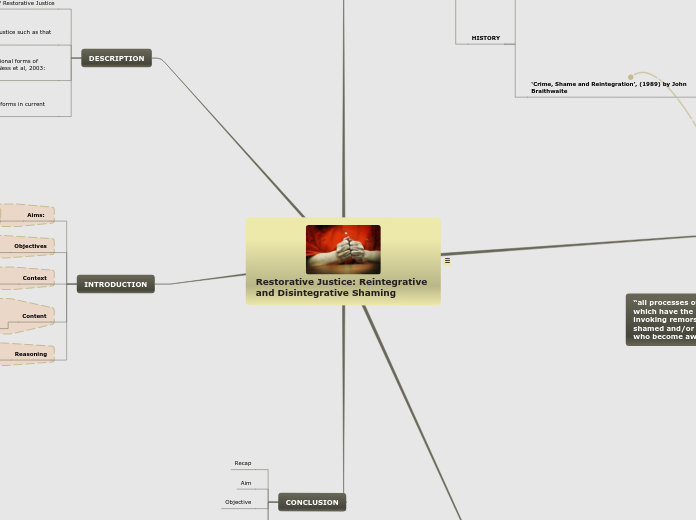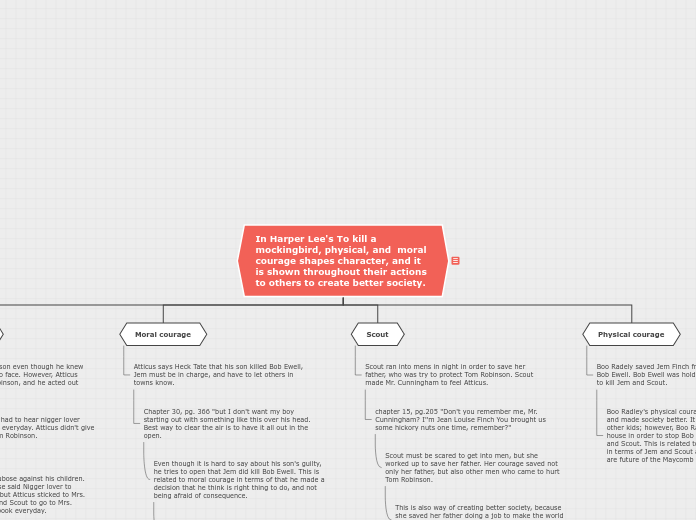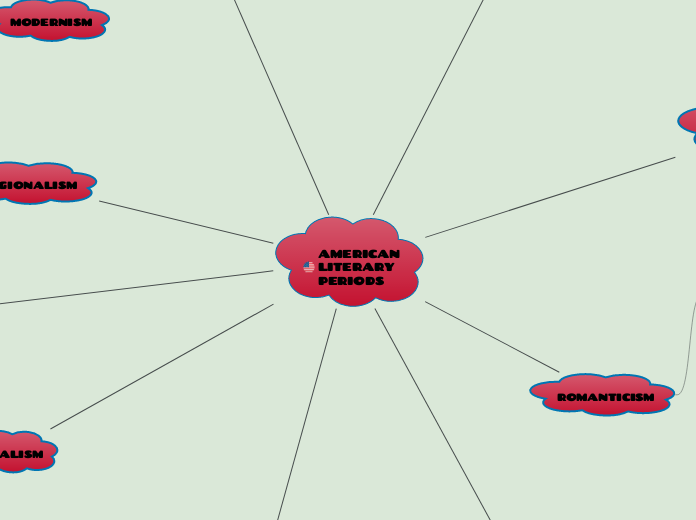MOVE ON TO EXPLORE HISTORICAL AND CONTEMPORARY EXAMPLES OF RESTORATIVE JUSTICE BOTH IN THEORY AND PRACTICE
“all processes of expressing disapproval which have the intention or the effect of invoking remorse in the person being shamed and/or condemnation by others who become aware of the shaming” (p.9).
Restorative Justice: Reintegrative and Disintegrative Shaming
Restorative Justice:
This mind map relates to question 4 in section A of the Crime and Punishment exam. The mind map covers a number of Central areas of analysis within the use of Restorative a Justice both theoretically and within criminal Justice.
Restorative Justice is commonly known as a theory of criminal justice that focuses on crime as an act against another individual or community rather than the state. To simplify this notion, the theory of criminal justice is the branch of philosophy of law that deals with criminal justice and in particular punishment. The theory of criminal justice has deep connections to other areas of philosophy, such as political philosophy and ethics, as well as to criminal justice in practice.
As we have highlighted in many previous lecture, ‘Deterrence’ theory argues that the amount of punishment should be the minimum required to achieve the desired amount of deterrence. Most versions of retributive justice argue that the amount of punishment should be proportional to the amount of harm caused. Reform theory argues that the amount of punishment should be enough to cause reform in the offender.
However, some theories would argue that the amount of punishment is not important at all. The main philosophy of ‘Restorative Justice’ is to work to resolve conflict and repair harm. This aim is achieved by encouraging those that have caused harm (offenders), to acknowledge and understand the impact their actions have had on the victims of those crimes. This in turn provides them with an opportunity to make what is termed ‘Reparation’ for the offence.
In addition, ‘Restorative Justice’ also provides those that have suffered as a result of the offenders actions (victims) the opportunity to have what harm or loss they have sustained acknowledged and for reparation to be made for the loss incurred. Restorative Justice is a problem-solving approach to crime which involves the parties themselves, and the community generally, in an active relationship with statutory agencies. It is not any particular practice, but a set of principles which may orientate the general practice of any agency or group in relation to crime.
These principles are:
· making room for the personal involvement of those mainly concerned (particularly the offender and the victim, but also their families and communities)
· seeing crime problems in their social context
· a forward-looking (or preventative) problem-solving orientation
· flexibility of practice (creativity).
CONCLUSION
Main points of evaluation
Main points of analysis
Objective
Aim
Recap
INTRODUCTION
Reasoning
What was the reasoning behind these choices?
Content
What/Which research, studies, philosophies, theories, evidence have you analysed, evaluated, explored, discussed in an attempt to answer the question.
Context
In what context does the question relate to?
Objectives
How might you answer the question?
Aims:
What is the question asking?
DESCRIPTION
Restorative justice can take many different forms in current criminal Justice practice.
These are:
Peacemaking and Sentencing Circle (Canada)
Victim Offender mediation (North America and Canada)
Youth Offender Panels (United Kingdom)
Conferencing (United Kingdom, Australia, New Zealand, North America)
RJ represents a distinct alternative to traditional forms of Justice administered by youth courts (Van Ness et al, 2003: 5).
Restorative Justice views crime as a violation of persons and relationships that require repair and restoration (Cornwell, 2007:5).
Justice is achieved in a way which places 'decisions about how best to deal with the offence on those most effected (Morris, 2002:598).
Provide an official definition of restorative Justice such as that offered by Marshall (1995:5).
A process whereby parties with a stake in a particular offence, collectively resolve how to deal with the aftermath of an offence and its implications for the future (Marshall, 1995:5).
Definition of Restorative Justice
The theory of criminal Justice that defines crime as an act committed by a person against another person or community rather than an act against the state.
CRITICAL EVALUATION:
THE NEUROSCIENCE OF RESTORATIVE JUSTICE BY DANIEL REISEL
RESTORATIVE JUSTICE IN PRACTICE
Sherman and Strang state that the reduction in the frequency of re-offending found in this research was 27% less crime, 27% fewer victims following RJ.
Alongside the Sentencing Green Paper in December 2010 the Government published their own further analysis of the data behind the Shapland reports, quantifying the size of the reduction in the frequency of re-offending following RJ as 14%.
Shapland (2008) found that in randomised control trials of RJ with serious offences (robbery, burglary and violent offences) by adult offenders
RJ reduced the frequency of re-offending, leading to £9 savings for every £1 spent on restorative justice
85% of victims who took part were satisfied with the process
The majority of victims chose to participate in face-to-face meetings with the offender, when offered by a trained facilitator
RJ is frequently presented as innovative and thus to be differentiated from more established justice approaches (Morris and Young, 2000).
At one extreme, RJ is considered the 'third way', distanced from both Retribution and Rehabilitation (see for example Graef, 2000).
“While only 10% said ‘the punishment I might get’, was the most important consequence of arrest, 55% said either ‘What my family’ or ‘What my girlfriend’ would think about it. Another 12% ranked ‘the publicity or shame of having to appear in court’ as the most serious consequence” (ibid:192).
He proposed that shaming could be defined into two distinct categories.
DISINTEGRATIVE SHAMING
REINTEGRATIVE SHAMING
CRITICAL ANALYSIS
HISTORY
‘Crime, Shame and Reintegration’, (1989) by John Braithwaite
Braithwaite (1989:69-83) believed that sanctions imposed by relatives, friends or a personal relative collectively have more effect on criminal behaviour than sanctions imposed by a remote legal authority. This basis for Braithwaite was taken from the results of a Government Social Survey conducted by Zimring and Hawkins (1973:192), which asked youth’s to rank what they saw as the most important consequences of arrest:
Braithwaite (1999: 6) suggests that it would be better to think of restorative justice as being about ‘restoring victims, restoring offenders and restoring the communities’ which are affected by a crime, with the parties determining what ‘restoration’ means in each circumstance. Braithwaite took up the issue of the conditions under which societal reactions increase crime (as labelling theorists contend) or decrease crime (as advocates of punishment predict).
Legal violations evoke formal attempts by the state and informal efforts by intimates and community members to control the misconduct
The theory of RJ is by no means a new approach to crime and punishment. Notions of RJ were evident in the social construct of early primitive societies.
According to historians, human societies can be broken down into two distinct categories
State Society: within a state society, there is clear political leadership or hierarchies of authority and these are appointed to make key decisions about the governance of such societies.
Societies such as today' society has a permanent, highly centralised political organisation where crime is responded to through a formal process of governance in the form of an official criminal justice system and state sanctioning.
Acephalous Society: are the earliest type of society which existed without rulers and were the only type of human community for some 30,000 years. crime was viewed as a collective responsibility where individuals were bound to the group thus reducing the potential for actions that threatened that social group! one such action was crime.
After evaluating the harm, the society would regain its loss of balance by doing something for the victim or to the offender. The state of unbalance remained until the victim was satisfied with the resolution. Therefore, resolution was important for facilitating a return to normal life (Johnstone, 2003:111).
RESTORATIVE JUSTICE IN THEORY
this broad crime reduction strategy is essentially influenced by 'Abolitionism'
Abolitionists suggest that crime is not the object but is the product of crime control philosophies and institutions.
Social problems of which crime is one, are viewed as an inevitable part of everyday life and therefore cannot be delegated to professionals claiming to provide solutions.
Conflict between people is an inevitable consequence of crime.
When this conflict occurs, it is the job and function of RJ to help resolve the conflict and restore the balance in a just and fair way.
See Wright (2002) attached for an analysis of RJ as a victim-sensitive, community-based response to crime.
Restorative Justice also provides those who have suffered as a result of the offenders actions the opportunity to have what harm they have sustained acknowledged and for reparation to be made for the loss incurred.
RJ is a problem solving approach to crime which involves the parties themselves, and the community generally, in an active relationship with statutory agencies.
Justice is done in a way which places 'decisions about how best to deal with the offence on those most effected (Morris, 2002:598).
The main philosophy of RJ is to work to resolve conflict and repair harm
this is achieved by encouraging those that have caused harm to acknowledge and understand the impact their actions have on the victim of the offence.
Criticism: Is it always possible to achieve 'reparation'.
Agreements are key outcomes in RJ conferences. However, there is a debate over the effectiveness of such agreements to reduce post-conference offending (see Hayes et al (2014) attached).









